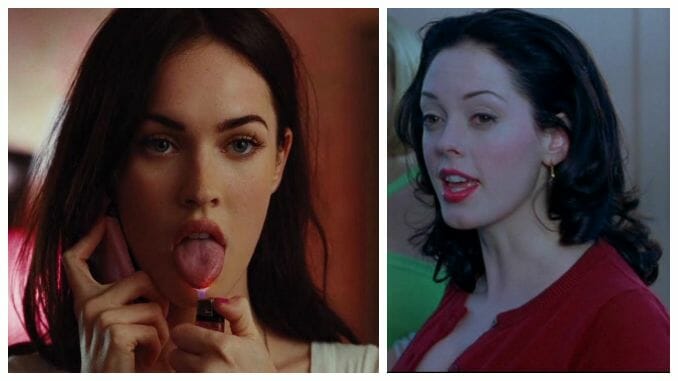How Jennifer’s Body and Jawbreaker‘s Monster Mean Girls Helped Me Confront Internalized Misogyny

The campy, ultra-feminine bitches of Y2K-adjacent high school movies live large in my head to this day. Growing up in the early 2000s, I quickly learned that a slow-motion walk in high heels and a tight shirt usually meant we were about to meet a girl that we were not supposed to like. She is attractive, she knows it and she’s probably going to be very mean. The Regina Georges, the Tom-Toms and the Heather Chandlers all exist in direct opposition to the “down-to-earth” girls who act as their foils, spewing out scathing one-liners while we root for their downfalls. Lately, I’ve been revisiting those mean girls whose evil cuts one level deeper: The ones who diss your outfit and then literally stab you in the chest, or try to eat your heart out. Through these monster mean girls, I found a way to confront my own.
I want to make a clear distinction right off the bat: I’m not talking about the women in horror who get to throw a couple of insults in before getting the “all sluts must die” trope treatment. These are the women holding the knives. They’re not outcasts a la Michael Myers or, to keep it in the realm of high school horror, Carrie. They’re lip-curling, sneering popular girls whose high school powers are akin to a lesser god. In fact, Jawbreaker sees its monstrous mean girl state flat-out that she is a god with the power to create and destroy.
The 1999 film’s Courtney (Rose McGowan) is about as unforgivably evil as it gets. Now, Jawbreaker wasn’t well-received when it debuted, and the time since certainly hasn’t done the script any favors. But slurs and plot points that have aged like milk aside, the movie is clearly leeching off the sort of salaciously evil mean girls that came before—Courtney sociopathically ruling the school with an iron fist, never once showing remorse for her high school crimes as she works to cover up the fact that she accidentally murdered her best friend. It’s a moment of uncomplicated victory when Courtney’s former best friend, Rebecca Gayheart’s Julie, receives a de-bimbofication and ultimately engineers Courtney’s downfall.
If you’ve been primed to hate the girl who rules the school, it doesn’t come as a shock when the general public isn’t so smitten as she kills the teen dream. Part of this is by design, of course: Courtney and her cohorts exist for the very purpose of society’s raised eyebrows and upturned noses. Their skimpy and ultra-girly personas range from the dumb blonde to a cold and calculating supervillian. They embody everything I was against when I was determined to align myself with the low-maintenance “cool girls” that stand to oppose and defeat their enemy stereotype.
It’s worth noting that a cult following, particularly in the LGBT community, exists for this movie and many others that share its kitschy, bitchy attitude: Jawbreaker was even treated to a screening at RuPaul’s DragCon. While the movie was generally a flop, it’s not entirely surprising to find it reclaimed by a community that celebrates the draggish ultra-feminine; the cringey camp and shocking dialogue can be either the crowning moment or nail in the coffin depending on the cultural lens one brings to these characters.
Cult followings aside, plenty of popular renditions of this type of girl have popped up in the mainstream since. Mean Girls, though not horrific, helped consciously put the trope into the public eye when Regina George (Rachel McAdams) defined it. Without Courtney and Regina—or even films with similar vibes, like Hello Mary Lou: Prom Night II or Heathers—I highly doubt about half the characters in the Ryan Murphy cinematic universe would exist.
-

-

-

-

-

-

-

-

-

-

-

-

-

-

-

-

-

-

-

-

-

-

-

-

-

-

-

-

-

-

-

-

-

-

-

-

-

-

-

-








































